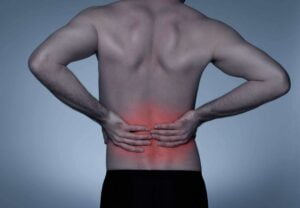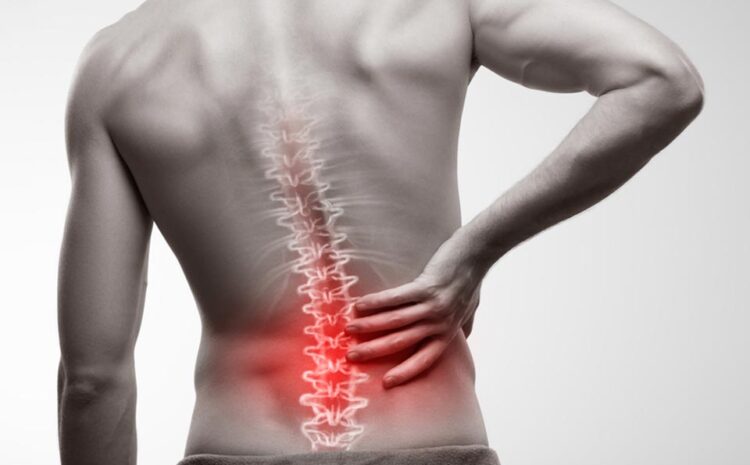In our busy and fast-paced lives, physical discomforts like acute back pain are increasingly becoming common, yet they’re seldom addressed with the urgency they deserve. We often dismiss it as a result of exhaustion, relegating it to the back of our minds until it evolves into something more serious. This blog is here to shed light on acute back pain – what it is, why it happens, and what you can do to alleviate and prevent it.
Contents
What Is Acute Back Pain?
 Acute back pain is a term that refers to pain felt in the back that comes on suddenly and typically lasts less than six weeks. It can range in intensity, from a minor annoyance to debilitating discomfort, and can significantly interfere with a person’s day-to-day activities. It’s important to distinguish acute back pain from chronic back pain, which lasts for more than three months. And is often progressive, meaning it worsens over time.
Acute back pain is a term that refers to pain felt in the back that comes on suddenly and typically lasts less than six weeks. It can range in intensity, from a minor annoyance to debilitating discomfort, and can significantly interfere with a person’s day-to-day activities. It’s important to distinguish acute back pain from chronic back pain, which lasts for more than three months. And is often progressive, meaning it worsens over time.
The nature of acute back pain can be quite varied. It could be sharp, piercing, or present as a dull ache. It might be confined to a small area or spread across the entire back. This can occur anywhere along your spine, from your neck to your tailbone, affecting structures such as the muscles, nerves, bones, discs, or tendons in the back. Despite its often temporary nature, it’s crucial to manage acute back pain effectively to prevent it from becoming a long-term, chronic issue.
What Are The Common Causes Behind Acute Back Pain?
Acute back pain can arise from a multitude of factors, often related to the stress or strain of everyday activities. Here are some common causes:
- Muscle or Ligament Strain: The most common cause of acute back pain is often a result of heavy lifting or a sudden awkward movement that can strain the muscles and spinal ligaments. If you’re in poor physical condition, constant strain on your back can lead to painful muscle spasms.
- Disc Injuries: Discs act as cushions between the bones (vertebrae) in your spine. If these discs get damaged due to trauma or wear and tear, they might bulge or rupture (herniate), causing pain.
- Vertebral Fractures: Fractures can happen if the bones in the spine weaken, such as from osteoporosis, or due to a sudden injury or accident.
- Arthritis: Certain types of arthritis can lead to inflammation in the lower back or cause spinal stenosis, a narrowing of the space around the spinal cord.
- Spinal Irregularities: If your spine curves in an unusual way, back pain can occur. An example is scoliosis, a condition in which the spine curves to the side.
Remember, this pain usually has a clear cause and resolves within a few days or weeks. However, persistent or worsening back pain should be evaluated by a healthcare professional to rule out more serious underlying conditions.
Can Gas Cause Acute Back Pain?
 Yes, gas can indeed cause acute back pain. When gas accumulates in the digestive system, it can lead to bloating and distension. That can further result in discomfort or pain that radiates to the back. The pain can vary from mild discomfort to severe pain and can be felt anywhere in the body, including the chest and back regions.
Yes, gas can indeed cause acute back pain. When gas accumulates in the digestive system, it can lead to bloating and distension. That can further result in discomfort or pain that radiates to the back. The pain can vary from mild discomfort to severe pain and can be felt anywhere in the body, including the chest and back regions.
This type of back pain usually resolves once the gas is passed or expelled. However, if you frequently experience severe back pain due to gas, or if it’s accompanied by other symptoms like unexplained weight loss, prolonged abdominal pain, changes in bowel habits, or blood in stool, it’s crucial to seek medical attention to rule out more serious conditions.
When Should You Be Worried?
While acute back pain is typically benign and self-limiting, there are times when it could signal a more serious condition. Here are some situations where you should seek immediate medical attention:
- Persistent Pain
If your back pain is severe and doesn’t improve with rest or is persisting beyond a few weeks, you should consult a healthcare provider.
- Radiating Pain
Pain that radiates down one or both legs. Especially if it extends below the knee, may indicate damage to the spine, such as a herniated disk or sciatica.
- Associated Symptoms
Symptoms like fever, unexplained weight loss, or incontinence (bladder or bowel control loss) accompanied by back pain could suggest a more serious underlying condition.
- Neurological Symptoms
If you experience weakness, numbness, or tingling in one or both legs, it might indicate nerve compression.
- Trauma
If your back pain started after a fall, an accident, or a blow to your back, it’s crucial to seek medical care promptly.
- Night Pain
Pain that wakes you up at night can sometimes indicate a serious condition.
Remember, this list is not exhaustive, and any new, severe, or persisting symptoms should be evaluated by a healthcare professional. Always trust your instincts when it comes to your health. If something doesn’t feel right, it’s better to be safe and seek medical advice.
What Are Some Home Remedies and Exercises for Acute Back Pain?
 Acute back pain can often be effectively managed at home through a combination of rest, gentle exercises, and other simple remedies. Here are a few strategies:
Acute back pain can often be effectively managed at home through a combination of rest, gentle exercises, and other simple remedies. Here are a few strategies:
Home Remedies
- Rest and Relaxation: While bed rest was once commonly advised for people with back pain, it’s now known that too much rest can weaken the muscles and make the problem worse. Instead, try to maintain your normal activities as much as possible. But avoid heavy lifting and activities that exacerbate the pain.
- Heat and Cold Therapy: Apply a hot or cold pack to the affected area. Cold can reduce inflammation and numb the area, while heat can relax the muscles and improve blood flow. It’s usually recommended to use cold for the first 48 hours after the onset of pain, then switch to heat.
- Over-the-Counter Pain Relievers: Non-prescription medications such as acetaminophen (Tylenol) or nonsteroidal anti-inflammatory drugs (NSAIDs), like ibuprofen (Advil, Motrin) can provide temporary relief from acute back pain.
Exercises
- Partial Crunches: This exercise can help strengthen your back and stomach muscles. Lie with knees bent and feet flat on the floor. Cross your arms over your chest or put your hands behind your neck. Tighten your stomach muscles and raise your shoulders off the floor, but avoid leading with your elbows or using arms to pull your neck off the floor.
- Hamstring Stretches: Lie on your back with one knee bent. Thread a towel beneath the ball of the foot on the unbent leg. Pull back on the towel slowly, straightening the knee and flexing the foot. Hold for about 20-30 seconds, then repeat on the other leg.
- Press-Up Back Extensions: Begin by lying on your stomach with your hands under your shoulders. Push with your hands so your shoulders begin to lift off the floor. If it’s comfortable for you, put your elbows on the floor directly under your shoulders and hold this position for several seconds.
Remember, it’s essential to consult with a healthcare provider before starting any exercise regimen, especially if you’re in pain. They can provide appropriate exercises based on your specific condition. Also, if any exercise increases the pain, stop it immediately and seek professional advice.
What Are Some Ways To Prevent It?
Here are some strategies to help prevent acute back pain:
Exercise Regularly
Engage in regular low-impact physical activities that don’t strain or jolt the back, like walking, swimming, or cycling. Core-strengthening exercises can also help condition the muscles in your back and abdomen. That is essential for proper spinal support and alignment.
Maintain a Healthy Weight
Carrying extra weight, especially around your midsection, can put additional stress on the muscles, ligaments, and tendons in your lower back. Maintaining a healthy weight can help prevent this.
Posture Matters
Be mindful of your posture during daily activities. Stand and sit up straight, avoid slouching, and keep your back in a neutral position. When sitting, use a chair with good lower back support, armrests, and a swivel base. Keep your knees and hips level.
Lift Properly
When lifting and carrying heavy objects, bend at the knees and hips, not the waist. Keep the load close to your body, and avoid lifting heavy objects above shoulder level.
Quit Smoking
Smoking can reduce blood flow to the lower spine, which can contribute to spinal disc degeneration and slow the healing process. Hence, quitting smoking is beneficial for back health.
Healthy Diet
Consuming a healthy diet rich in calcium and vitamin D can help promote bone strength and prevent conditions like osteoporosis that can lead to back pain.
Remember, prevention is always better than cure. Maintaining a healthy lifestyle not only prevents back pain but also promotes overall well-being. However, even with preventive measures, it’s possible to experience back pain. If you experience persistent or severe back pain, seek medical attention.
Conclusion
In conclusion, acute back pain, while common, should never be taken lightly. Though it often stems from everyday activities, it can sometimes be a signal of more serious underlying conditions. Hence, timely attention, proper care, and effective management are crucial. Remember, your body is your lifelong home, and its health directly impacts your quality of life.
By understanding the causes, signs, and remedies for acute back pain, as well as taking proactive measures for prevention, you can better navigate this common ailment and foster a healthier, more comfortable lifestyle. It’s always advisable to seek professional medical advice for persistent or severe back pain.
If you’re experiencing Back pain, physical therapy for back pain at PhysioMantra can help: Book an online physical therapy session.



